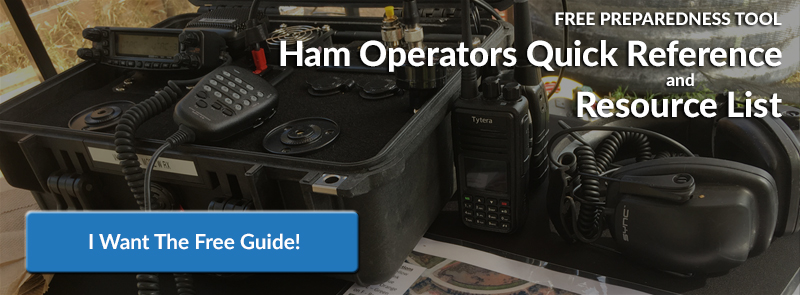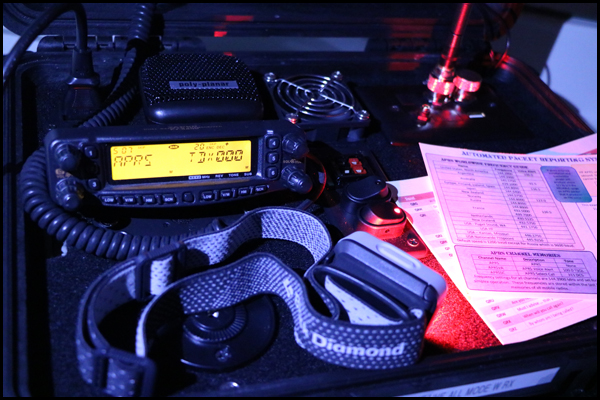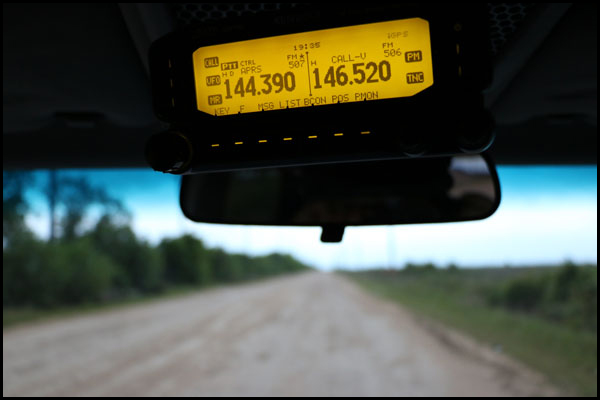Ham Radio for Beginners: Simplex and Duplex Communications for Preparedness
An amateur radio license brings a multitude of communications capabilities to the table. However, to unlock its capabilities it is important to first understand some of its most popular means; simplex and repeater communications. Here is a simplified explanation of simplex and repeater operations as well as some advantages and disadvantages to serve your preparedness objectives.
Simplex Communications
Simplex radio communications is the simplest means of communications. It uses a single frequency for the transmission and receiving of a radio signal. When you are using a little store-bought FRS walkie talkie, you are communicating in simplex mode. Simplex is also used in amateur communications. It is a sometimes called “direct” and uses one frequency in the amateur radio band to transmit and receive a signal directly to another radio. No equipment in between, just radio to radio.
Simplex communications is commonly used with an FM signal in the 2-meter (144-148 Mhz) and 70cm bands (420-450 Mhz). These are arguably are the most popular communications bands and are what we will focus on in this article.
Technical readers, yes, I am aware of ground wave propagation, sky-wave propagation, and that simplex modes are used elsewhere in amateur radio, but lets keep it simple for other readers in this one. Savvy?
Limitations
Simplex is limited to a number of factors, primarily that of distance. Simplex communications will give you the least amount of distance for communications. Since you are communicating radio to radio a number of factors can impact your distance such as:
- Line of Sight
- Antenna Height
- Power
- Obstructions
- Terrain
- Vegetation
- Curvature of the Earth
In general, the higher your antenna, the further you will be able to communicate. Typically, you see a few miles handheld to handheld, and 3-10 miles mobile to mobile. But it is completely dependent on the factors above. I wouldn’t expect much more.
The Benefits
While this is limited, it can provide some decent benefits for short range communications such as:
- Simple to use, and easy to set up in the radio.
- Not much technical knowledge required to operate.
- Limited range means less people can pick up the signal.
- Keeps repeaters clear for other radio traffic (we will discuss repeaters next)
Simplex operations should be in everyone’s communications plan. Use for base camp talk around communications or when talking around your neighborhood (assuming everyone is an amateur operator, or part of a amateur club).
Calling Frequencies
Remember the simplex calling frequencies for 2-Meter and 70cm Bands (listed below). Think of its use similar to Marine Channel 16 or the old CB Channel 19 (but for amateurs). This is the location to “hail” for other operators listening, and make contact from there.
2-Meter Band Calling Frequency
146.520 Mhz
70-Centimeter Band Calling Frequency
446.000 Mhz
If you don’t know the local repeater or are in an unknown area, it can be a great way to establish initial communications with other hams.
Repeaters
Repeaters are where amateur radio really shines. From a preparedness perspective, this is one of the main reasons to get into amateur radio.
Duplex Communications
Repeaters utilize duplex communications (actually half duplex in most cases) where two frequencies are used for communications. One frequency is used to transmit the signal from the transmitting party to the repeater, the other is used by other listeners to receive the signal back from the repeater at the same time you are talking. So, you talk (or transmit) your signal on a different frequency than you listen to (receive).
This all takes place in near real time, so others hear your signal on the receive frequency at the same time you are transmitting to the repeater on the transmit frequency.
What Are Repeaters
Repeaters are essentially a good set of radios with a really good antenna system placed at an elevated point such as a tower or mountain peak. The higher elevation increases the repeater’s “line of sight” and give it a longer range than just simplex communications.
Total Capable Range
While the radio waves are still limited to many of the factors we discussed in simplex above; the antenna is higher so there is less risk of them becoming an issue (i.e. obstructions, vegetation, etc.). This allows a range of 25+ miles in many cases.
Since the repeater is at a centralized location, and can reach out 25+ miles, this can give a total range of over 50 miles, allowing communications over a broad area. To explain further let’s use a circle example to explain range.
If the repeater is at the center of a circle, and the radius is 25 miles, the diameter of the circle is 50 miles. This diameter is the repeaters total range. Meaning if you are on the edge of the repeaters coverage area (the edge of the circle) you can communicate completely to the other edge of the circle approximately 50 miles from your location.
Extended Range
The largest benefit of a repeater is the extended range. You can now communicate across entire cities with the same amateur radio you used to communicate only a few miles (in simplex). Just by communicating through a repeater.
Large Autonomous and Independent Communications Network
There are over 21,000 documented amateur repeaters across the USA, Canada, and Mexico (RepeaterBook.com). It is the largest, free to use, group of repeaters in the country. Each repeater is managed and maintained independently by other hams or clubs. In addition, repeaters are designed to operate autonomously, meaning someone doesn’t have to be there to “trigger” the repeater when a person wants to talk. Assuming they are turned on, they are ready and standing by to receive and retransmit a message across the coverage area.
Similar to how it would be difficult to take down the internet, the same goes for amateur radio repeaters. Although one site or even a few sites could go down or get damaged, there are a number of repeaters that remain online in the area for communications. Since amateur radio repeaters aren’t a “true” network like the internet, you would have to change channels to a different repeater, and so would the person you are trying to talk to. Because many areas have multiple repeaters covering the area, a communications system remains online.
Back-Up Power
Many repeaters include the ability to connect to a battery backup so they can run for a period of time if the power grid goes down. In addition, many are co-located with commercial radio sites with generator power. Thus, providing a 3 tier back up power redundancy plan. I would definitely recommend identifying these sites in your area by making contact with the repeater owner. They can provide a key role in your emergency communication plan.
Back-Up Antennas
Some repeater sites also maintain a back-up antenna on the tower, usually at a lower height or decreased performance. However, with this in place, it allows for less down time if the primary antenna gets damaged as the repeater can be brought back online with the turn of a knob or the swap of a cable.
For those amateurs who maintain or are considering putting up a repeater, keep this idea in mind. If you will have to pay for a company to do a tower climb for your install, in many cases it is cheaper to add a back-up antenna during the initial visit than asking them to run one after issues with the primary antenna. You may also experience significant delays when attempting to get a tower crew out after severe weather which will significantly increase the downtime of your repeater if a back-up is not ready to go. If you maintain your own tower, it can save you a climb in potentially unsafe conditions.
Linked Repeater Systems
Linked repeaters are a group of networked repeaters, each with different frequencies (in most cases). These repeaters are linked through the internet so that the audio is shared across all the repeaters at the same time. This significantly increases the range associated with the system by hundreds of miles.
Link Activation and Deactivation
In some linked systems these “links” can be remotely activated and deactivated via computer or DTMF tones over the air. This is used to control activity on the repeater or the linked system. In my experience, most linked systems are active at all times, but some are left deactivated except for special situations such as severe weather, disasters, or special events. We described the different functions in more detail below.
Function with Link Off
With the link turned off, the repeater functions like a standard repeater and only local traffic is heard (only people on that repeater frequency pair).
Function with Link On
When the link is activated, the radio traffic is “linked” between all repeaters in the system, so the same audio is heard across all sites.
Let’s Clear It Up
Clear as mud? Let’s use an example to try and clear things up. Lets look at a linked repeater system with 2 repeaters. If you have a repeater that covers City A with a range of around 40 miles on 146.640 Mhz. You have a second repeater on a different frequency, say 145.150 Mhz, that covers City B with a range of about 30 miles. The cites are about 100 miles apart so the coverage areas don’t overlap. When the link is deactivated, people in City A will only hear others in City A. When the link is activated, if someone talks in City A, it will be heard by others in City A and also those in City B, and visa versa.
So why spend all this time explain it? Linked repeaters allow a substantial communications network when the links between them are active. Some linked systems cover entire states, allowing the amateur operators to communicate an extremely large distance on the 2 meter or 70 cm bands. It is important to note, if the backbone connectivity is lost, the repeater stays online and functions as a standard repeater (as described above).
If you are building these into your communications plan, take into account that the link may do down, so have an alternative.
Disadvantages of Repeater Systems
Although repeater systems offer a large range of options and benefits, there are also a few limitations from the preparedness perspective that should be pointed out.
 Conversations Are Heard at Long Ranges
Conversations Are Heard at Long Ranges
In an emergency incident, operational security (OPSEC) is key. In these cases, some communications may be better kept secure. This can be a challenge when communicating with amateur repeaters as the conversation can be heard by anyone listening in or around the repeater coverage area. If on a linked repeater system, they can be heard across the entire linked system coverage area.
Linked Systems Get Busy Fast
While linked systems provide a substantial range advantage when the links are active, they also share the audio between each other. This means a single conversation is shared across multiple repeaters sites, keeping all of them tied up. If these repeaters weren’t linked, they could all be hosting different conversations at the same time. During emergencies, an increase in radio traffic can fill up the linked systems quick, so plan for this ahead of time.
Autopatches: Making a Phone Call via Radio
While these are a somewhat dying feature in today’s cell phone age, they are still important to note. An autopatch is an interconnect module that connects a repeater to the telephone network. This allows the amateur radio operator to make a phone call from their radio with the DTMF keypad. While all persons monitoring the repeater can hear (and potentially talk on) the call, it is a great tool when available where cell coverage isn’t an option. Keep a lookout for this legacy feature in your area, and document how to use it.
Repeater Directory
There are a few repeater directories published online and in book form. Repeater directories document the amateur radio repeaters across a given country or location. These are important to have on hand when traveling in areas that you are unfamiliar.
Online Directories
One of the largest online amateur radio repeater directories is RepeaterBook.com. RepeaterBook offers a database that is constantly updated with new and changing information. It is completely free and also offers an app for iOS and Android platforms. The website offers multiple search tools including: national, multi-state, along travel routes, specific location, and keyword search. It allows multiple filters, documents linked systems, and emergency service repeaters.
The phone application is where RepeaterBook really shines. It downloads the database for offline use so it is still operational when you are without cell service. The app automatically finds the repeaters near you based on your phone’s location. A manual location can also be used assuming you know the 6 digit Maidenhead Grid Square (look yours up here). It also allows result filtering by band and service.
ARRL Repeater Directory
The ARRL Repeater Directory is published in book form every few years, I always recommend keeping one on hand. It’s like a paper roadmap for an amateur radio operator. Although they are technically out of date as soon as they are printed, even one a few years old is a great reference with no technology required. Keep one in your vehicles and on the bookshelf.
Wrap Up
Have relatives across town that you can’t talk to currently if cell phones or power goes down? Ham licenses and repeaters can solve the problem.
Want to be able to communicate in virtually in any city as you travel across the country and not be limited to cell phones? Ham radio repeaters can make it happen.
These are just a few ways simplex and repeater communications can benefit you as an amateur radio operator when preparing for emergencies. Take the opportunity to brainstorm at how these two models of communicating could benefit your family communications plan.
Get our free ham radio quick reference and resource guide to find out more about ham radio and serve your emergency preparedness needs by clicking here.






My brother and I are looking to find a new hobby that we can get into together and we were thinking of purchasing a couple of ham radios. It was cool that you mentioned that ham radios can be used to communicate with other people if power or cell phones go out. It seems like ham radios are a good thing to own if you are trying to be prepared for a disaster situation.
In the event that the repeaters are rendered in operable what other ham band would be a reasonable alternative. My club has two nets a week and the repeaters are reliable. But I feel that there should be a backup for point to point communications that should also be established and occasionally used. The 40 meter band basically covers the whole country and is well used. But I really would like some insight to covering the same area the repeater covers but without the use of the repeater. On the water 10 meter was used to out reach VHF radios. Any information would be helpful
Great informative discussion! My only comment is that a “newby” might not understand about frequencies to use. One would ask, “well, if I transmit on a different than someone receives on, how do I know what frequency transmit to use?” or, “How does the other person know what frequency to receive on?” or someone might ask, “What frequencies do I use,.. is there a repeater frequency I set my radio on, do I set my radio on another frequency, or what?”
These are questions that a brand new “novice” might ask.
Hi. Great article.
I’m studying now for my Technician license. I’m about ready to take the test. I am currently licensed for GRMS which is a great local solution for me in our rural area here in Southern Indiana. I am wanting to work on the 10 meter band and HF so hence the reason I want my license. Then I will take the general license and that will be it for my needs.
Great article though, and thanks..
Regards from South Central Indiana. USA.
Tim